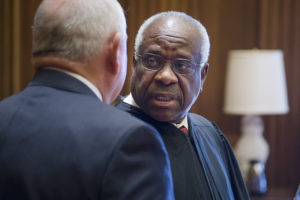
Sonny Perdue is sworn in as the 31st Secretary of Agriculture by U.S. Supreme Court Justice Clarence Thomas with his wife Mary and family April 25, 2017, at the Supreme Court in Washington, D.C.. Photo by Preston Keres
The best way to stop discriminating on the basis of race, is to stop discriminating on the basis of race. — Chief Justice John Roberts
Why has the Supreme Court never seemed entirely comfortable with “race-based admissions”? The reasons are understandable, reports the WSJ in “Notable and Quotable.”
Counting by race violates the principle of a colorblind Constitution. It’s contrary to the 14th Amendment and to the Civil Rights Act. It’s unfair and unjust and it often hurts the very people it is trying to help.
From Matthew Continetti, writing in the December issue of Commentary:
The left has treated the affirmative-action cases as racial analogues to last term’s Dobbs v. Jackson Women’s Health Organization, in which the Court reversed the Roe v. Wade (1973) decision and restored abortion law to the states.
After Dobbs, the media portrayed the Court as antidemocratic, counter-majoritarian, and contemptuous of public opinion. And they had half a point. The polls really did show that the public was against overturning Roe v. Wade. For Washington Post columnist Ruth Marcus, the Students for Fair Admissions cases, like Dobbs, have been taken up by a “heedless” Court eager to embroil itself “in some of the most inflammatory issues confronting the nation” after a “cataclysmic” term.
There’s a problem with this analysis, however. . . . Americans support general efforts to promote opportunity and inclusion. But they oppose the explicit use of race as a criterion in college admissions, hiring, and promotion. The Court won’t be risking a backlash if it ends affirmative action. It will be on the side of the people.
If you’re willing to fight for Main Street America, click here to sign up for the Richardcyoung.com free weekly email.





